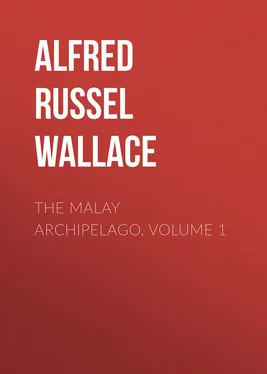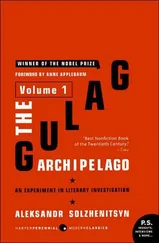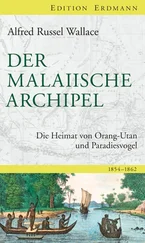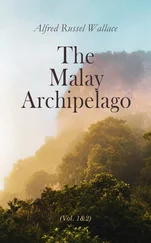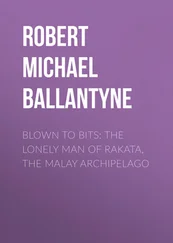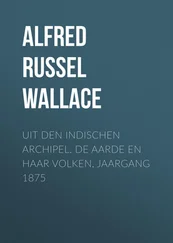Alfred Wallace - The Malay Archipelago, Volume 1
Здесь есть возможность читать онлайн «Alfred Wallace - The Malay Archipelago, Volume 1» — ознакомительный отрывок электронной книги совершенно бесплатно, а после прочтения отрывка купить полную версию. В некоторых случаях можно слушать аудио, скачать через торрент в формате fb2 и присутствует краткое содержание. Жанр: Путешествия и география, foreign_edu, foreign_antique, foreign_prose, на английском языке. Описание произведения, (предисловие) а так же отзывы посетителей доступны на портале библиотеки ЛибКат.
- Название:The Malay Archipelago, Volume 1
- Автор:
- Жанр:
- Год:неизвестен
- ISBN:нет данных
- Рейтинг книги:4 / 5. Голосов: 1
-
Избранное:Добавить в избранное
- Отзывы:
-
Ваша оценка:
- 80
- 1
- 2
- 3
- 4
- 5
The Malay Archipelago, Volume 1: краткое содержание, описание и аннотация
Предлагаем к чтению аннотацию, описание, краткое содержание или предисловие (зависит от того, что написал сам автор книги «The Malay Archipelago, Volume 1»). Если вы не нашли необходимую информацию о книге — напишите в комментариях, мы постараемся отыскать её.
The Malay Archipelago, Volume 1 — читать онлайн ознакомительный отрывок
Ниже представлен текст книги, разбитый по страницам. Система сохранения места последней прочитанной страницы, позволяет с удобством читать онлайн бесплатно книгу «The Malay Archipelago, Volume 1», без необходимости каждый раз заново искать на чём Вы остановились. Поставьте закладку, и сможете в любой момент перейти на страницу, на которой закончили чтение.
Интервал:
Закладка:
Strange to say, however, several persons declare that they have measured Orangs of a much larger size. Temminck, in his Monograph of the Orang, says that he has just received news of the capture of a specimen 5 feet 3 inches high. Unfortunately, it never seems to have a reached Holland, for nothing has since been heard of any such animal. Mr. St. John, in his "Life in the Forests of the Far East," vol. ii. p. 237, tells us of an Orang shot by a friend of his, which was 5 feet 2 inches from the heel to the top of the head, the arm 17 inches in girth, and the wrist 12 inches! The head alone was brought to Sarawak, and Mr. St. John tells us that he assisted to measure this, and that it was 15 inches broad by 14 long. Unfortunately, even this skull appears not to have been preserved, for no specimen corresponding to these dimensions has yet reached England.
In a letter from Sir James Brooke, dated October 1857 in which he acknowledges the receipt of my Papers on the Orang, published in the "Annals and Magazine of Natural History," he sends me the measurements of a specimen killed by his nephew, which I will give exactly as I received it: "September 3rd, 1867, killed female Orangutan. Height, from head to heel, 4 feet 6 inches. Stretch from fingers to fingers across body, 6 feet 1 inch. Breadth of face, including callosities, 11 inches." Now, in these dimensions, there is palpably one error; for in every Orang yet measured by any naturalist, an expanse of arms of 6 feet 1 inch corresponds to a height of about 3 feet 6 inches, while the largest specimens of 4 feet to 4 feet 2 inches high, always have the extended arms as much as 7 feet 3 inches to 7 feet 8 inches. It is, in fact, one of the characters of the genus to have the arms so long that an animal standing nearly erect can rest its fingers on the ground. A height of 4 feet 6 inches would therefore require a stretch of arms of at least 8 feet! If it were only 6 feet to that height, as given in the dimensions quoted, the animal would not be an Orang at all, but a new genus of apes, differing materially in habits and mode of progression. But Mr. Johnson, who shot this animal, and who knows Orangs well, evidently considered it to be one; and we have therefore to judge whether it is more probable that he made a mistake of two feet in the stretch of the arms, or of one foot in the height. The latter error is certainly the easiest to make, and it will bring his animal into agreement, as to proportions and size, with all those which exist in Europe. How easy it is to be deceived as to the height of these animals is well shown in the case of the Sumatran Orang, the skin of which was described by Dr. Clarke Abel. The captain and crew who killed this animal declared that when alive he exceeded the tallest man, and looked so gigantic that they thought he was 7 feet high; but that, when he was killed and lay upon the ground, they found he was only about 6 feet. Now it will hardly be credited that the skin of this identical animal exists in the Calcutta Museum, and Mr. Blyth, the late curator, states "that it is by no means one of the largest size"; which means that it is about 4 feet high!
Having these undoubted examples of error in the dimensions of Orangs, it is not too much to conclude that Mr. St. John's friend made a similar error of measurement, or rather, perhaps, of memory; for we are not told that the dimensions were noted down at the time they were made. The only figures given by Mr. St. John on his own authority are that "the head was 15 inches broad by 14 inches long." As my largest male was 13 1/2 broad across the face, measured as soon as the animal was killed, I can quite understand that when the head arrived at Sarawak from the Batang-Lupar, after two or three days' voyage, it was so swollen by decomposition as to measure an inch more than when it was fresh. On the whole, therefore, I think it will be allowed, that up to this time we have not the least reliable evidence of the existence of Orangs in Borneo more than 4 feet 2 inches high.
CHAPTER V. BORNEO—JOURNEY INTO THE INTERIOR
As the wet season was approaching, I determined to return to Sarawak, sending all my collections with Charles Allen around by sea, while I myself proposed to go up to the sources of the Sadong River and descend by the Sarawak valley. As the route was somewhat difficult, I took the smallest quantity of baggage, and only one servant, a Malay lad named Bujon, who knew the language of the Sadong Dyaks, with whom he had traded. We left the mines on the 27th of November, and the next day reached the Malay village of Gúdong, where I stayed a short time to buy fruit and eggs, and called upon the Datu Bandar, or Malay governor of the place. He lived in a large, and well-built house, very dirty outside and in, and was very inquisitive about my business, and particularly about the coal-mines. These puzzle the natives exceedingly, as they cannot understand the extensive and costly preparations for working coal, and cannot believe it is to be used only as fuel when wood is so abundant and so easily obtained. It was evident that Europeans seldom came here, for numbers of women skeltered away as I walked through the village and one girl about ten or twelve years old, who had just brought a bamboo full of water from the river, threw it down with a cry of horror and alarm the moment she caught sight of me, turned around and jumped into the stream. She swam beautifully, and kept looking back as if expecting I would follow her, screaming violently all the time; while a number of men and boys were laughing at her ignorant terror.
At Jahi, the next village, the stream became so swift in consequence of a flood, that my heavy boat could make no way, and I was obliged to send it back and go on in a very small open one. So far the river had been very monotonous, the banks being cultivated as rice-fields, and little thatched huts alone breaking the unpicturesque line of muddy bank crowned with tall grasses, and backed by the top of the forest behind the cultivated ground. A few hours beyond Jahi we passed the limits of cultivation, and had the beautiful virgin forest coming down to the water's edge, with its palms and creepers, its noble trees, its ferns, and epiphytes. The banks of the river were, however, still generally flooded, and we had some difficulty in finding a dry spot to sleep on. Early in the morning we reached Empugnan, a small Malay village, situated at the foot of an isolated mountain which had been visible from the mouth of the Simunjon River. Beyond here the tides are not felt, and we now entered upon a district of elevated forest, with a finer vegetation. Large trees stretch out their arms across the stream, and the steep, earthy banks are clothed with ferns and zingiberaceous plants.
Early in the afternoon we arrived at Tabókan, the first village of the Hill Dyaks. On an open space near the river, about twenty boys were playing at a game something like what we call "prisoner's base;" their ornaments of beads and brass wire and their gay-coloured kerchiefs and waist-cloths showing to much advantage, and forming a very pleasing sight. On being called by Bujon, they immediately left their game to carry my things up to the "headhouse,"—a circular building attached to most Dyak villages, and serving as a lodging for strangers, the place for trade, the sleeping-room of the unmarried youths, and the general council-chamber. It is elevated on lofty posts, has a large fireplace in the middle and windows in the roof all round, and forms a very pleasant and comfortable abode. In the evening it was crowded with young men and boys, who came to look at me. They were mostly fine young fellows, and I could not help admiring the simplicity and elegance of their costume. Their only dress is the long "chawat," or waist-cloth, which hangs down before and behind. It is generally of blue cotton, ending in three broad bands of red, blue, and white. Those who can afford it wear a handkerchief on the head, which is either red, with a narrow border of gold lace, or of three colours, like the "chawat." The large flat moon-shaped brass earrings, the heavy necklace of white or black beads, rows of brass rings on the arms and legs, and armlets of white shell, all serve to relieve and set off the pure reddish brown skin and jet-black hair. Add to this the little pouch containing materials for betel-chewing, and a long slender knife, both invariably worn at the side, and you have the everyday dress of the young Dyak gentleman.
Читать дальшеИнтервал:
Закладка:
Похожие книги на «The Malay Archipelago, Volume 1»
Представляем Вашему вниманию похожие книги на «The Malay Archipelago, Volume 1» списком для выбора. Мы отобрали схожую по названию и смыслу литературу в надежде предоставить читателям больше вариантов отыскать новые, интересные, ещё непрочитанные произведения.
Обсуждение, отзывы о книге «The Malay Archipelago, Volume 1» и просто собственные мнения читателей. Оставьте ваши комментарии, напишите, что Вы думаете о произведении, его смысле или главных героях. Укажите что конкретно понравилось, а что нет, и почему Вы так считаете.
